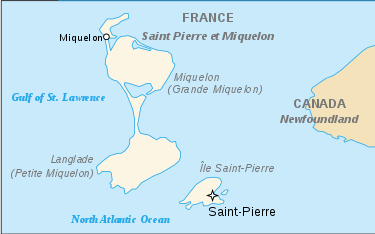The Cruiser Submarine that Brought the War to America: The Surcouf!
A submarine designed to circumvent the Washington Naval Treaty, a couple of barely inhabitable rocks in the St. Lawrence Seaway and the resignation of Secretary of State Cordell Hull. What do they have in common? The story of how World War II came to North America.
The MN Surcouf was a French submarine designed to get around naval treaty restrictions on cruisers. While the Washington Treaty of 1922 placed limits on the number and size of cruisers, it did not touch on submarines. As a result, the Marine National developed a behemoth of a submarine which carried as its main armament two eight inch guns in a turret. Named the Surcouf after a famous French pirate, the eight inch guns were the main armament of the submarine and, while having limited range and taking a number of minutes to be made ready, were obviously far beyond the normal armament of a submarine.
Shortly after the Surcouf was laid down, this class of submarines was outlawed by an update to the treaty and it became a one-of-a-kind cruiser/submarine.
The Surcouf was in Brest for a refit when the war broke out and limped to Plymouth to prevent being turned over to the Germans. When the British tried to take control of the French navy for the Free French, there was gunfire and casualties on the Surcouf--action which made it of suspected loyalty. In fact, the Surcouf had Royal Navy personnel attached to it to ensure its loyalty. It became part of the Free French Navy and spent the next year escorting convoys in the North Atlantic.
The MN Surcouf was a French submarine designed to get around naval treaty restrictions on cruisers. While the Washington Treaty of 1922 placed limits on the number and size of cruisers, it did not touch on submarines. As a result, the Marine National developed a behemoth of a submarine which carried as its main armament two eight inch guns in a turret. Named the Surcouf after a famous French pirate, the eight inch guns were the main armament of the submarine and, while having limited range and taking a number of minutes to be made ready, were obviously far beyond the normal armament of a submarine.
Shortly after the Surcouf was laid down, this class of submarines was outlawed by an update to the treaty and it became a one-of-a-kind cruiser/submarine.
The Surcouf was in Brest for a refit when the war broke out and limped to Plymouth to prevent being turned over to the Germans. When the British tried to take control of the French navy for the Free French, there was gunfire and casualties on the Surcouf--action which made it of suspected loyalty. In fact, the Surcouf had Royal Navy personnel attached to it to ensure its loyalty. It became part of the Free French Navy and spent the next year escorting convoys in the North Atlantic.
 |
| click to enlarge. |
On Christmas Eve, 1941, the Surcouf, along with the frigates Mimosa, Aconit and Alysse, against the orders of its American and British allies landed at a Vichy French outpost off of Newfoundland. The islands of Saint Pierre and Miquelon were barely more than rocks; fishing villages that serviced the Grand Banks. The islands were in desperate shape, as they technically were Vichy territory but had nowhere to get supplies and nowhere to ship its catch (the west coast of France was controlled by the Germans.) Starvation was a real threat and the Vichy government was almost universally hated by the population.
With only 12 gendarmes as an occupying force, the French Marines easily took control with not a shot fired. It was, after all, Christmas.
When word reached Washington, Secretary of State Cordell Hull, trying to prevent an outbreak of hostilities with Vichy France, was livid. De Gaulle had asked if he could take control of the islands and had been told in no uncertain terms that he could not. He ordered the action anyway.
Roosevelt and Churchill were together in Washington that Christmas and an enraged Hull found them, well, amused. He threatened to resign and Roosevelt promised to resolve some sort of solution.
After this, the Surcouf was to be sent to the Pacific, where presumably it would cause less mischief, but it never arrived. Presumably, it was accidentally sunk by US bombers, a patrol plane or a collision with a freighter. Or some combination of all three. Its wreckage was never found.
I looked for scenarios related too the Surcouf, but apparently there was no action at Brest in 1940 and, let's face it, nothing of interest in Sainte Pierre and Miquelon. It is a sad end to a rather unique breed of submarine.




Comments